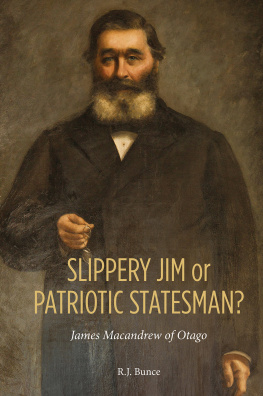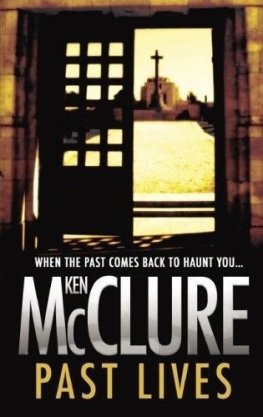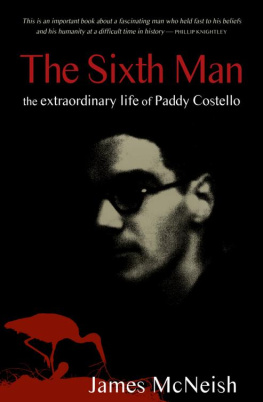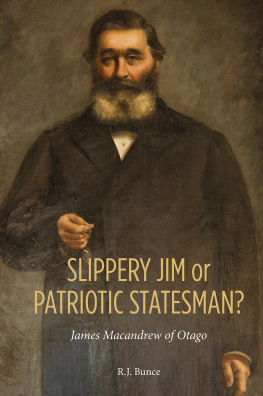



To Elizabeth, and to John Haynes who showed the way.
Published by Otago University Press
Level 1, 398 Cumberland Street
Dunedin, New Zealand
www.otago.ac.nz/press
First published 2018
Copyright R. J. Bunce
The moral rights of the author have been asserted.
ISBN 978-1-98-853135-9 (print)
ISBN 978-1-98-859211-4 (EPUB)
ISBN 978-1-98-859212-1 (Kindle)
ISBN 978-1-98-859213-8 (ePdf)
A catalogue record for this book is available from the National Library of New Zealand. This book is copyright. Except for the purpose of fair review, no part may be stored or transmitted in any form or by any means, electronic or mechanical, including recording or storage in any information retrieval system, without permission in writing from the publishers.
No reproduction may be made, whether by photocopying or by any other means, unless a licence has been obtained from the publisher.
Front cover: This portrait of Macandrew by Kate Sperry hangs in the stairwell of the University of Otagos Clocktower Building. Photography Allan Ramsay.
Back cover: The only extant bust of James Macandrew stands outside Toit Otago Settlers Museum in Dunedin. Author photograph.
Editor: Imogen Coxhead
Design/layout: Lucy Richardson
Indexer: Carol Dawber
Ebook conversion 2019 by meBooks
Contents
J ames Macandrew spent much of his life in the public spotlight, so a large collection of newspaper reportage on his activities is available. Any collection of personal papers, so vital to biography to explain his private life and to understand what motivated him, is absent, which may explain why he has been overlooked. Public records and the private views of his contemporaries provide most of the material for this biography, which focuses particularly on his public service and his political career.
Macandrews descendants have been enthusiastically helpful with discussion and the loan of family records. I particularly wish to thank Ruth Anderson, Marsha and Hunter Donaldson, Jane Harcourt, Anne Hubbard, Neal Macandrew and Sheryl Macandrew Morton. Denis Le Cren, in his family history of the Rich and Macandrew families, has provided a valuable summary of Macandrews life. Kate Wilson, a great-granddaughter of Macandrew, kindly made available her collection of Macandrew family papers, which includes five letters written by James Macandrew one to his wife, three to his daughter Mabel and one to his son Hunter.
Charles Waddy, a descendant of Thomas Reynolds Jnr, lent me his detailed but unpublished history of the Reynolds family and generously made time to review my manuscript.
I was encouraged to write this biography by Professors David McKenzie and Tom Brooking of the University of Otago. Supervision of the doctoral thesis at Victoria University of Wellington, from which this book emerged, was provided by Associate Professor Jim McAloon and Professor James Belich.
My thanks go to Dr Andr Brett of the University of Wollongong, who gave me invaluable guidance and encouragement during the writing of the manuscript, and to Dr Michael Stevens of the University of Otago, who set me right on Ngi Tahu history.
Professional assistance was provided in Dunedin by Alison Breeze of Dunedin City Archives, Jill Haley of Toit Otago Settlers Museum, Alison Clarke of the Hocken Collections, Gregor Macaulay of the University of Otago and Jane Smallfield of Otago Girls High School. In Wellington, assistance came from Katie de Roo of Archives New Zealand, David Colquhoun of the Alexander Turnbull Library and Lindsay Milne at the Parliamentary Library. Derek Oliver of the National Library of Scotland in Edinburgh located a number of Macandrews letters and a previously unsighted business card.
I am grateful to Lydia Wevers, who provided technical support and good company while I wrote this book, and the Stout Research Centre for New Zealand Studies at Victoria University of Wellington, which provided a distraction-free environment.
Publisher Rachel Scott of Otago University Press has made this book a reality, and editor Imogen Coxhead showed me how to improve the original manuscript immeasurably: thank you both.
Finally, I wish to thank my wife Elizabeth for her encouragement and support during the writing of this biography, and my children, Jeremy, Oliver and Melanie and their partners Angela, Greer and Genevieve: you keep my feet on the ground.
A Presbyterian manse occupied the land to the left of the wharf; to the right a church and a schoolhouse stood at the bottom of a steep hill, beyond which lay the flat northern reaches of the town.
A short walk up Jetty Street led Macandrew to Princes Street, the settlements main thoroughfare. This ran south to a tidal inlet, later reclaimed as the Market Reserve, and to the north spanned Toit Stream, scaled Bell Hill and crossed Moray Place and its central reserve (later known as the Octagon). Here it was renamed George Street and continued through swampy ground to a river known as the Water of Leith.
This unprepossessing village would be the base for Macandrews spectacular business and political careers, and he would be involved in many aspects of its meteoric growth. By the time of his death in a carriage accident in 1887, Dunedin would have 45,514 European residents and would be the second city of New Zealand, its streets paved by the gold extracted from the hinterland. It would boast substantial civic buildings, stone churches, the countrys first university, factories, steam trams, a cable car to the spreading hill suburbs and a ferry service to the harbour-side settlements.

James Macandrew landed on this jetty in 1851. This is reputed to be the earliest known photograph of Dunedin, taken in 1852 from Bell Hill, looking south along Princes Street. Macandrews Manse Street store, with its long roof and three dormer windows, is visible to the right of Princes Street, nearer to the hill.
Muir & Moodie reprint, Album 359 P1990-015-36-001, Hocken Collections, Uare Taoka o Hkena, University of Otago
Few people today know of James Macandrew, yet for 36 years from 1851 there was scarcely a day when he did not feature, for reasons both admirable and notorious, in one of New Zealands many newspapers. His political career spanned three unique periods of New Zealands history: he was directly involved with the establishment of self-government, the abolition of provincial government and George Greys 187779 ministry. New Zealands parliament attracted talented men during Queen Victorias reign, and service at both provincial and colonial levels of government was obligatory for a small clique of the colonys earliest European settlers. In the bear pit that was the General Assembly, powerful personalities dominated and opportunities abounded for intrigue and powerbroking.

Dunedin developed rapidly during the 1860s gold rush. This 1867 photo looks down Jetty Street from Princes Street to the wharf where, 16 years later, Macandrew first landed in Dunedin.
Next page














